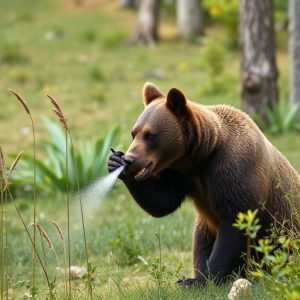Decomp and Alternative Sprays: Eco-Conscious Defense Against Bears
The Environmental Effects of Bear Spray Decomposition have both immediate and long-term impacts on p…….
The Environmental Effects of Bear Spray Decomposition have both immediate and long-term impacts on plant life, habitats, soil, water bodies, and vegetation. Rapid decomposition ensures quick action but reduces potency, while slow breakdown prolongs irritation. Optimizing storage, weather conditions, and outdoor activities can enhance spray effectiveness during bear encounters. Researchers and manufacturers are transitioning to biodegradable and natural plant-derived alternatives, minimizing ecological contamination and promoting safe, sustainable wildlife interactions.
“In regions where black bears roam, knowing how to deter these powerful creatures is vital for personal safety. This article delves into the world of bear spray, exploring its composition, effectiveness, and environmental impact. We dissect the role of decomposition in determining spray efficacy and uncover potential alternatives that mitigate ecological concerns. Understanding these factors is crucial for both outdoor enthusiasts and those living in areas with high bear activity, ensuring safe interactions with these majestic yet potentially dangerous animals.”
- Understanding Bear Spray Composition and Environmental Impact
- The Role of Decomposition in Bear Spray Efficacy
- Mitigating Ecological Concerns: Sustainable Bear Spray Alternatives
Understanding Bear Spray Composition and Environmental Impact
Bear spray, also known as urushiol-based spray, is a popular defense mechanism against black bears. Its composition includes a range of chemicals derived from plants in the Sumac family. When sprayed, these chemicals can cause irritation and discomfort to the bear’s eyes, nose, and respiratory system. Understanding the environmental impact of bear spray decomposition is crucial for its responsible use and safety.
The Environmental Effects of Bear Spray Decomposition involve both short-term and long-term consequences. Initially, the spray can disrupt plant life and wildlife habitats due to its caustic nature. However, over time, as the spray breaks down, it becomes less harmful to ecosystems. The primary chemical components eventually return to the soil, water bodies, or vegetation in a modified form, minimizing their negative impact on the environment. This process is influenced by factors such as temperature, moisture levels, and sunlight exposure, which play a role in the speed of decomposition.
The Role of Decomposition in Bear Spray Efficacy
The effectiveness of bear spray is influenced by various factors, with one key aspect being the speed at which it decomposes in the environment. Bear spray is designed to create a barrier between the user and the bear by irritating the animal’s eyes, nose, and respiratory system. However, once sprayed, it is susceptible to degradation from environmental elements such as sunlight, wind, and moisture.
The Environmental Effects of Bear Spray Decomposition play a crucial role in its overall performance. Rapid decomposition can ensure the spray remains potent when needed, while slow breakdown allows for a longer-lasting effect. Understanding these factors helps users select bear spray that aligns with their specific outdoor activities, be it hiking in dense forests or camping in remote areas. Proper storage and awareness of local weather conditions also contribute to maintaining the spray’s efficacy during encounters with black bears.
Mitigating Ecological Concerns: Sustainable Bear Spray Alternatives
In the quest for effective bear spray alternatives, it’s crucial to consider the ecological implications beyond just potency. Traditional bear sprays often contain chemicals that can have harmful environmental effects once they decompose. These chemicals may persist in soil and water bodies, potentially impacting non-target wildlife and aquatic ecosystems. As awareness of these environmental concerns grows, researchers and manufacturers are exploring sustainable options that balance protection against bears with minimal ecological disruption.
One promising approach involves developing bear spray formulations with biodegradable components, reducing the risk of long-term environmental contamination. Additionally, using natural repellents derived from plants can offer a chemical-free alternative with less potential for ecosystem disruption. Such innovations not only cater to safety needs but also promote sustainable practices, ensuring that wildlife encounters remain positive for both humans and nature.
Bear spray, while effective as a defense mechanism, has significant environmental effects, particularly regarding decomposition. Understanding how these sprays break down is crucial for mitigating ecological concerns. As we explore sustainable alternatives, it becomes evident that the search for environmentally friendly bear spray options is vital for preserving ecosystems and coexisting harmoniously with these majestic creatures. By considering both composition and impact, we can navigate towards a more sustainable future while ensuring our safety in bear country.


